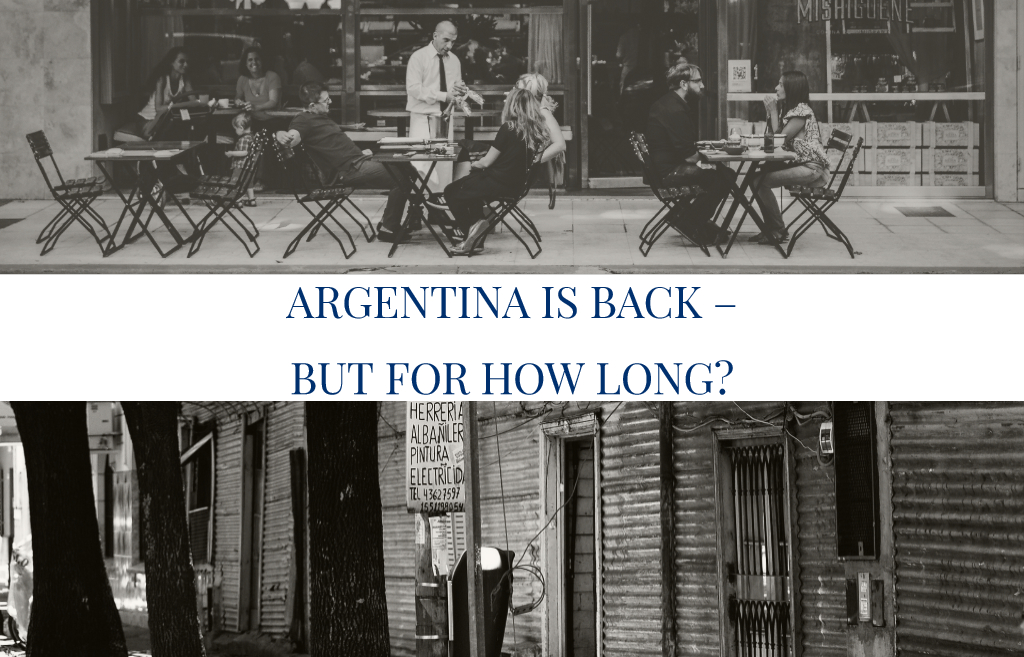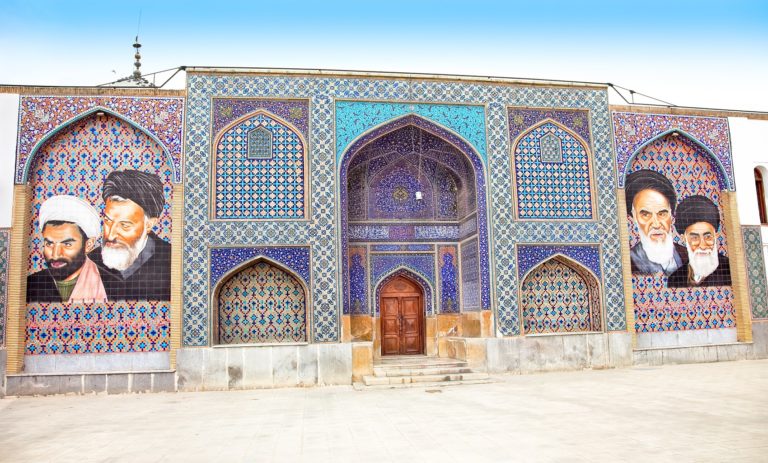Argentina is Back in Business in 2019 – But for How Long?
In 2016, I followed the development of Argentina’s recovery with some delight. Since its financial collapse and its subsequent recovery that took place after the shocking year of 2002, the country and its citizens went through a very painful adjustment period. But once again, the Argentina people proofed that in the deepest crisis we humans are capable of adaptation and enormous resilience.
I was happy to write in 2016, that Argentina was back in business and “with a bang.” That year, it was preparing to issue a record-breaking 100-year bond to yield-hungry investors. Yes, Argentina was back in business returning to international capital markets and everyone was delighted, including bankers, international investors, and the Argentinian elite. So what changed?
Since the Armageddon-like moments following the immediate financial collapse in 2002, it was a hard time for everyone in Argentina. Horrific inflation, shortages of essential commodities and lack of foreign investments had plagued the country for years. Workers around the country had to improvise. They created business communities to restart abandoned factories and production facilities. Many owners fled the country in panic never to return.
But things slowly turned around. Thanks to an increase in commodity prices, Argentina got some much-needed tailwind. After all, Argentina is a major exporter of soybeans and other natural resources, and with China’s rise to the top better times were trickling down the food chain. Local businesses in Argentina recovered, with it its Argentinian pesos and the stock markets.
Entering April 2016, I observed the development between an influential Hedge Fund (Elliott Capital Management) and the Argentinian government, that included blackmailing, top-level diplomacy and even the seizure of Argentinian navy property in form of a training vessel that docked in Ghana in 2012. This should give us some thoughts on how powerful US hedge funds have become over the years, even influencing the political process in the US with lofty campaign contributions.

Good news for Argentina – but will it last?
What caught my attention about Argentina, however, was the fact that it was planning to return to international financial markets. In the lengthy restructuring process of its existing debt, the media widely reported that the default ended with payments to the principal bondholders in early 2016. By November 2016 Argentina announced that it had settled with additional creditors for US$475 million.
In reaction to this, the country received standing ovations from the very top of global finance. The bond sale “is a major step forward,” said Agustin Carstens, head of the IMF world lender’s Monetary and Financial Committee. “It is very good to have a country as important as Argentina putting the house in order.”
“Argentina is back,” said Finance Minister Alfonso Prat-Gay in Washington. It seems a new cycle of debt and default might have begun, and it needs to be discussed, what the Argentinean elite has learned from financial markets and international investors in the previous crisis – 15 years back. Some have hinted, that this is already a full generation past and a kind of “great forgetting” might have set in already.
This “forgetting” should be rewarded with a mighty bond issuance. In June 2017, Argentina sold $2.75 billion of US dollar-denominated 100-year bonds at an effective yield of 8%. The history of defaults seemed to be forgotten. In the end, nearly $15 billion would be placed with yield-hungry investors. As the international press wrote “The sale came at a time when investors were hungry for high-yielding debt, but it also showed confidence in president Mauricio Macri and his program of pro-market reforms.”
Yet, I was under the impression that Argentina managed well in the last 15 years, comfortably surviving and thriving without the need of global financial markets. It made me wonder, who the real profiteers will be in the next round of debt issuance, repayment, refinance and finally default.
But I might be wrong and “this time it’s different.” Maybe, Argentina had finally learned its lesson to act finally responsible and capable of weathering any adverse economic conditions. Once again, Argentina was back in business and ready to take on international debt, of course, denominated in USD. Unfortunately, the enthusiasm was short lived as 2018 should proof.
Argentina Update 2018
Fast forward to May 2018. From being the darling of global investors after returning to the international finance scene, Argentina once again made headlines. Unfortunately, not as the darling of investors anymore, but as a beggar for more money! The century bond that was initially trading up to 105% of its face value, had dropped to 85%.
Remember, it just had issued a record-breaking 100-year bond with a yield of just 7.9 % and investors loved it – because there wasn’t much else around that yielded so much with a clean sheet as Argentina had. Apparently, they ignored the fact that the country had defaulted eight times in the past 200 years.
Argentina is back again, but this time begging for more money. In May President Mauricio Macri asked the International Monetary Fund for help after the peso tumbled to
record lows. Surprisingly, the IMF was very open to their requests. It even expressed understanding of Argentina’s dire financial conditions.
The result: The IMF agreed to a more than 50-billion-U.S.-dollar bailout, the biggest in the global lender’s history. Of course, not without imposing new terms on the Argentina government to enact more reforms, fiscal discipline and regular audits by international institutions. Hard terms it may seem, but the rescue plan was drafted and enacted in record time thanks to both parties being understanding and cooperative.
We could argue that this time it’s not Argentina’s fault, but a chain of unfortunate macro-economic events caused the bonds to crumble and Argentina’s finance to go to shambles. It’s embarrassing to say the least, but the main blame should lie with investors and the facilitators of these financing options.
Bankers and Greedy Investors are to Blame
Higher rates worldwide, less liquidity and as a consequence fluctuating currencies are well-known parameters of changing credit cycles. In times of modern risk management and historic case studies, you can tell me that these risks that are now unfolding have not been known at the time of issuance?
But at least, Argentina learned to cope with its financial crisis and how to deal with institutions such as the IMF the quickest and least painful way. IMF offered its full cooperation under the leadership of Christine Lagard. The IMF was willing to help Argentina, provided that Argentina’s leadership is willing to fulfill its demand.
We can only hope that it also learned to act on its promises to improve public finances through painful reforms and more fiscal discipline. Those who are responsible in the first place have already cashed out long before in terms of receiving fees upfront and trading the discounts and spreads that come along with fresh bonds. It’s the people of Argentina who will have to deal with future payments to the rest of the world.
Argentina Outlook for 2019
2019 will not be easier for Argentina, and we should be cautious with overcommitting to invest or lend money to countries who can’t deal with modern finance. Another crisis of confidence for over-leveraged borrowers could be around the corner and Argentina is on top of the list.
According to local economists, 2019 “will not be the most encouraging.” Nevertheless, economists agree there are some reasons for cautious optimism. It is expected that the country should suffer less turbulence than it has in 2018 according.
“We expect the economy to fall, possibly beginning to recover towards the end of the year, towards the last four months, but that won’t help to turn things around, to go from being in the red to being in the black,” said Pablo Salvador, who teaches at the National University of Cuyo in the central province of Mendoza.
“Possibly, inflation will be much lower” than the 47 percent annual rate expected for 2018, he told a Chinese News publication in a recent interview.
“The government is estimating between 23 and 25 percent. Today, that seems feasible, but it all depends on how the central bank manages the situation and how the government manages policy,” he added.
The development of the US dollar should be watched with the utmost care, as in times of global crises, the lead currency usually strengthens, alongside the JPY and the CHF. This, in turn, would put further pressure on Argentina’s debt and debt servicing.
Since the start of the year, the peso lost more than half its value against the U.S. dollar and “the dollar could continue to strengthen,” he noted. On the bright side, thanks to a weaker peso, “Argentina’s economy has become more competitive” as “exports have begun to recover and imports have decreased substantially,” said Salvador.
Unfortunately, this positive effect is neutralized by the cooling of the world economy and China’s substantial slow down. A decline of economic activity usually has a negative impact on core agricultural and industrial commodities should be expected. All important factors to consider in 2019 when considering to invest in Argentina.
In my opinion, emerging markets investors can call themselves lucky that the escapades in May 2018 didn’t spread to other emerging market countries. Though Turkey was at a near financial collapse, those two countries didn’t cause panic among international investors. Remember, the US stock markets were still strong and flourishing in the Summer of 2018. Many tech companies achieved new record highs and the one trillion dollar mark was broken twice!
2019 promises to be less bullish, even though market experts, bankers and politicians try to convince us otherwise. But with the lead stock market in decline, emerging markets won’t fare any better!






